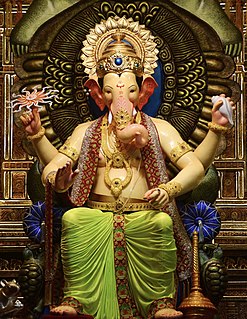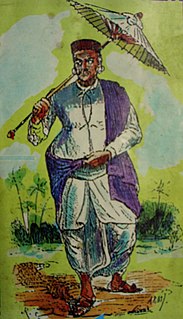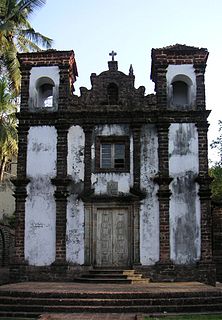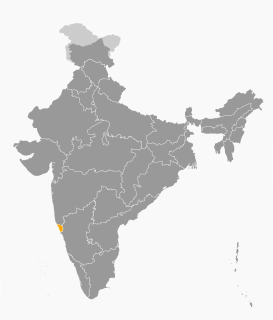
Konkani is an Indo-Aryan language spoken by the Konkani people along the western coast of India. It is one of the 22 scheduled languages mentioned in the 8th schedule of the Indian Constitution and the official language of the Indian state of Goa. The first Konkani inscription is dated 1187 A.D. It is a minority language in Karnataka, Maharashtra, Kerala, Gujarat and Dadra and Nagar Haveli and Daman and Diu.

Ganesh Chaturthi, also known as Vinayaka Chaturthi, is a Hindu festival celebrating the arrival of Ganesh to earth from Kailash Parvat with his mother Goddess Parvati/Gauri. The festival is marked with the installation of Ganesh clay idols privately in homes, or publicly on elaborate pandals. Observations include chanting of Vedic hymns and Hindu texts such as, prayers and brata (fasting). Offerings and prasadam from the daily prayers, that are distributed from the pandal to the community, include sweets such as modaka as it is believed to be a favourite of Lord Ganesh. The festival ends on the tenth day after start, when the idol is carried in a public procession with music and group chanting, then immersed in a nearby body of water such as a river or sea. In Mumbai alone, around 150,000 statues are immersed annually. Thereafter the clay idol dissolves and Ganesh is believed to return to Mount Kailash to Parvati and Shiva. The festival celebrates Lord Ganesh as the God of New Beginnings and the Remover of Obstacles as well as the god of wisdom and intelligence and is observed throughout India, especially in the states such as Maharashtra, Goa, Karnataka, Rajasthan, Madhya Pradesh, Andhra Pradesh, Telangana, Odisha, West Bengal, Gujarat and Chhattisgarh, and is celebrated privately at home in Tamil Nadu in 2020 due to Covid-19 Pandemic. Ganesh Chaturthi is also observed in Nepal and by the Hindu diaspora elsewhere such as in Australia, New Zealand, Canada, Singapore, Malaysia, Trinidad and Tobago, Guyana, Suriname, other parts of the Caribbean, Fiji, Mauritius, South Africa United States, and Europe. In the Gregorian calendar, Ganesh Chaturthi falls between 22 August and 20 September every year.

The Goa Inquisition was an extension of the Portuguese Inquisition in colonial-era Portuguese India. The Inquisition was established by the colonial era Inquisition in Portuguese India to enforce Catholic orthodoxy in the Indian colonies of the Portuguese Empire, and to counter the New Christians, who were accused of "crypto-Hinduism", and the Old Christian Nasranis, accused of "Judaising". It was established in 1560, briefly suppressed from 1774 to 1778, continued thereafter until finally abolished in 1820. The Inquisition punished those who had converted to Catholicism but were suspected by Jesuit clergy of practising their previous religion in secret. Predominantly, those targeted were accused of Crypto-Hinduism. A few dozen criminally-charged natives were imprisoned, publicly flogged and, dependent on the criminal charge, sentenced to death. The Inquisitors also seized and burnt any books written in Sanskrit, Dutch, English, or Konkani, on the suspicions that they contain deviationist or Protestant material.
Konkani people are an ethno-linguistic community who inhabit and originate the Konkan region of south-western India, and speak various dialects of the Konkani language. They also reside in Kanara, Malabar, Goa and Damaon, and Maharashtra.

Mário João Carlos do Rosário de Brito Miranda, popularly known as Mario Miranda or Mario de Miranda, was an Indian cartoonist and painter based in Loutolim in the Indian state of Goa.
This article is about the Caste System in Goa, and describes the various Jātis or sub-castes to be found among Hindus belonging to the four varnas, as well as those outside of them. The traditional Hindu caste system was also retained by the Goan Catholic community, and as such, their castes are mentioned here in this article.
Goan Catholics are an ethno-religious community of Christians following the Roman Rite from the state of Goa on the west coast of India. They are Konkani people and speak the Konkani language.
Goans is the demonym used to describe the people native to Goa, India, who form an ethno-linguistic group resulting from the assimilation of Indo-Aryan, Dravidian, Indo-Portuguese and Austro-Asiatic ethnic and/or linguistic ancestries. They speak different dialects of Konkani natively. Goanese is an incorrect usage for Goans.

Maria Aurora Couto is an Indian writer, and educationalist from Goa. She is best known for her book Goa: A Daughter's Story. She currently lives in the North Goan village of Aldona. She helped start the DD Kosambi Festival of Ideas and has been involved in activities of Goa University.

The Daivadnya Brahmins are a Konkani people and a subgroup of the Hindu Brahmin castes native to the Konkan, predominantly residing in Goa and Damaon, Canara, coastal Maharashtra, and Kerala.

Sanna and plural Sannas are spongy steamed savoury rice cakes originating from the west Coast of Indian subcontinent. They are popular in Goa and Mangalore in India, especially among the Goans, the Konkani diaspora of Karnataka and of a small community settled in Kerala, and the East Indians and the Kupari community based in and around Mumbai.

Tristão de Bragança Cunha, alternatively spelled as Tristao de Braganza Cunha, was a prominent Indian nationalist and anti-colonial activist from Goa. He is popularly known as the "Father of Goan nationalism", and was the organiser of the first movement to end Portuguese rule in Goa.

Francis Xavier Clooney is an American Jesuit Roman Catholic priest and scholar in the teachings of Hinduism. He is currently a professor at Harvard Divinity School in Cambridge, Massachusetts. He has been nominated as the winner of the John Courtney Murray Award in 2017 for his distinguished theological achievement.

Lambert Mascarenhas is a journalist, freedom activist and writer from Goa. His family hails from the Goan Catholic community, a Christian community in Goa.

The indigenous population of the erstwhile Portuguese colony of Goa underwent a large-scale conversion from Hinduism to Christianity after its conquest and occupation by the Portuguese Empire, led by admiral Afonso de Albuquerque in 1510. After conversion to Roman Catholicism, they were granted Portuguese citizenship. Almost all the present-day Goan Catholics are descendants of these local converts to the religion. They constitute the largest Christian community in Goa and account for 25 per cent of the total Catholic population in India. The Mangalorean Catholic and Karwari Catholic communities of the Indian state of Karnataka are also largely descended from these Goan converts. East Indian Catholics of northern Konkan districts and Christians of Damaon also have some Portuguese Goan ancestry and interaction, East Indians were formerly Portuguese overseas citizens until when Bombay was handed over as a royal dowry to the British East India Company by the Portuguese Viceroyalty.

The Goan Muslims are a minority community who follow Islam in the western Indian coastal state of Goa. They are native to Goa, unlike recent Muslim migrants from Karnataka. They are commonly referred as Moir by Goan Catholics and Hindus. Moir is derived from the Portuguese word mour (Moors). The Portuguese called them Mouros because they were called Mouros and later generalized as Mouros.

The following outline is provided as an overview of and topical guide to Goa:

The Portuguese controlled Goa until 1961, when India took over. Only a very small fraction of Goans speak Portuguese nowadays. Although an essential religious language, there were 1,500 students learning Portuguese in Goa in 2015; totaling a number of 10,000 – 12,000 Portuguese speakers in the state.
Antonio Xavier Trindade (1870–1935) was an important painter of the Bombay School in the early 20th century.














